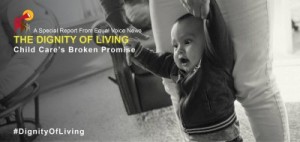
Angelica Gonzalez hold her son, a toddler, in November 2015 at the house where they are living on the Olympic Peninsula in Washington state. Photo by Mike Kane for Equal Voice News – See more at: http://www.equalvoiceforfamilies.org/the-dignity-of-living-child-cares-broken-promise/#sthash.JVvgn7ha.dpuf
When Angelica Gonzalez left home at age 11, all she wanted was a safe place where she could go back to school.
Abandoned by her mentally ill mother, she was raising herself on the streets of her Phoenix neighborhood, never in school, and narrowly avoiding the gangs and crime that seemed to be everywhere.
“I just knew if I stayed there, something really bad was going to happen. You never knew when your luck would finally run out,” Gonzalez said.
By the time Gonzalez turned 26, she was far from those streets, with a degree from the University of Washington Tacoma and a decent apartment outside Seattle. A public child care subsidy held her new life together. The subsidy allowed her to afford one of the region’s best child care centers for her toddler and keep a promising job at a local elementary school. While it paid only roughly $20,000 a year, the job offered a bright future.
ChildcareGraphicInsert400
A single setback – the loss of that subsidy – fractured Gonzalez’s new life and stability. A rare child support check from her ex-husband pushed her over the program’s income limit temporarily and halted her subsidy indefinitely.
Gonzalez was told she could try again in a couple of months, but she could not wait that long. She had to pay her child care bill now, and realized she could not rely on the system or her ex-husband.
She struggled to pay $800 a month for child care – more than half her paycheck – by taking a second job, then leaving both jobs for higher pay selling paint. Since she now worked evenings, she had to send her daughters, then 1 and 7 years old, to unlicensed and unreliable child care.
Without stable child care, other challenges – a deteriorating relationship, health problems and rising rent – became that much harder to manage. Within two years, Gonzalez was unemployed and she and her two daughters were homeless.
Angelica Gonzalez, seen in November 2015, lives with her children on the Olympic Peninsula in Washington state. Photo by Mike Kane for Equal Voice News
Angelica Gonzalez, seen in November 2015, lives with her children on the Olympic Peninsula in Washington state. Photo by Mike Kane for Equal Voice News
“I am not trying to use the system by asking for child care. I am trying to become stable and productive, and contribute to society,” Gonzalez said. “Obviously, the system failed me and I couldn’t continue to let the system fail me.”
Gonzalez’s story is echoed by parents in Alabama, Illinois, Mississippi, New Mexico and California. Child care options and subsidy programs vary among states, but parents around the country cite the same obstacle: an inaccessible system defined by rigid eligibility requirements.
Families worry that a small raise could cost them a subsidy worth far more than the raise itself. Instead of high-quality child care, they find waiting lists and few options during evening and overnight shifts demanded by low-wage jobs in the modern economy.
They deal with a child care system that sometimes appears to challenge rather than support them as they try to build more secure lives for their families. Instead, they want a system that preserves subsidies as they earn more but still can’t afford child care.
They want child care that reflects what it means to be working, poor and raising children in America.
A Parent From Alabama
“You find yourself really making some tough decisions as a parent. Whether to go back to work and trying to find child care and risk three-quarters of your or four-fifths of the check for child care.”
“I voiced my opinion about the system. I said your way, your system, you are not enabling parents to be better citizens of Alabama.”
— Mother, raising four children, who asked to remain anonymous.
“I get scared every time I get a raise because I think I am not going to be able to qualify. And it shouldn’t be like that. It should be like ‘Keep going. Keep going,’” said Marlene Herrera, a 42-year-old mother of two who works for the Ounce of Prevention Fund in Chicago.
The problem is that child care subsidy programs, which rely on federal and state funding, are not built around the needs and schedules of working poor parents, according to Mary Ignatius, statewide organizer for California-based Parent Voices, which focuses on making child care more accessible and affordable.
“I think the biggest challenge is that the child care system requires families to fit into that system, instead of creating a system that is adaptable to the needs of families,” Ignatius said.
“There is a wait-list. The hours don’t work. You have to take three buses to get to programs. There are so many layers to the choices parents make, and there is such a dismissal of low-income parents’ ability to make good choices.”
Another central challenge is money. Limited public funding is a main reason why a child care subsidy is one of the least accessible parts of the public safety net, according to Elizabeth Lower-Basch, director of Income and Work Supports at the Center for Law and Social Policy (CLASP), a progressive think tank in Washington, DC. In the U.S., only one out of six children eligible for child care support under federal guidelines actually receives it, largely because of a lack of public funding, according to CLASP.
A Parent From California
“I was very grateful for having child care. (But), I was constantly moving up against a lot of barriers, just the bureaucracy of it all was just kind of frustrating.”
 “There was no transition for me with the child care. I was always really uneasy, month to month my income would change. I didn’t know what would happen next month.”
“There was no transition for me with the child care. I was always really uneasy, month to month my income would change. I didn’t know what would happen next month.”
— Parent, who asked to remain anonymous.
Without that support, many low-income families can’t afford good child care, which costs between $4,800 and $17,000 a year for center-based infant care, according to a 2015 report from Child Care Aware of America, a clearinghouse of information and resources about early education.
Despite child care’s high cost, in most states (39), families earning anything above 200 percent of the poverty line did not qualify for child care aid in 2015, the National Women’s Law Center found.
Parents “shouldn’t be in this position where their child care costs are eating up so much of their income that it doesn’t make sense for them to be in the work force,” said Lauren Hipp, campaign director for the national grassroots group MomsRising.
“We need more funding so that families can fully participate in the work force and have their kids in care.”
“It was all unraveling.”
When Angelica Gonzalez received one child support check from her ex-husband, she lost more than a child care subsidy. The loss ricocheted through her life, disrupting her career, children and housing.
With a subsidy, Gonzalez could afford high-quality child care and keep her job at Sunnycrest Elementary school, where she could eat lunch with her older daughter, who was in first grade, every day and work toward a better position in the school’s administration. She was home in the evenings, often cooking salmon and steamed vegetables, reading bedtime stories to her two daughters, and helping with homework.
A Parent From Miss.
“Right now, it just seems child care is available 7 (a.m.) to 6 (p.m.). In order to really become self-sufficient you need flexible child care that’s fully funded.”
“Fully funding child care would really make a difference in my life, and I know in other families lives.”
— Annita Bonner, 32, mother of two.
Without the subsidy, her child care bill soared from $15 a month to more than $800. Even after she picked up a second job, she could not pay her bills. So she left her promising job at Sunnycrest for a management-training position at a paint store.

Angelica Gonzalez, seen in November 2015, lives with her children on the Olympic Peninsula in Washington state. Photo by Mike Kane for Equal Voice News
Gonzalez could no longer afford the child care center where her toddler was enrolled. Even if she could have, she now worked in the evening, when it and most other high-quality providers were closed. Her only option was to try a series of unlicensed home-based programs, but each one had problems.
At night, her youngest daughter told her how she was punched by other children, nearly hit by a car and missed meals. One day, Gonzalez’s neighbors called because her daughter was wandering in a parking lot, apparently unsupervised.
Instead of salmon, her daughters now ate hot dogs. Bedtime stories were left unread, and homework wasn’t completed because Gonzalez worked deep into the evening. When she collected her children at the end of her day they were often asleep. Meanwhile, she slipped into another volatile relationship.
“It was all unraveling,” Gonzalez, now 29, recalled.
Rather than keep her daughters in unreliable and dangerous care, she quit working to find a better paying job. But, she could not apply for a child care subsidy while she looked, only when she was working. Finally, she found a position in marketing 45 miles away, but when she looked for decent child care within a 40-minute drive all she found were waiting lists. Without good child care, she had to turn the job down.
Angelica Gonzalez hold her son, a toddler, in November 2015 at the house where they are living on the Olympic Peninsula in Washington state. Photo by Mike Kane for Equal Voice News
Angelica Gonzalez hold her son, a toddler, in November 2015 at the house where they are living on the Olympic Peninsula in Washington state. Photo by Mike Kane for Equal Voice News
As a single mother in a low-paying job with no support from her family, the loss of child care aid wasn’t Gonzalez’s only challenge. That subsidy, however, created stability so she could address her other challenges, including building a career, raising a healthy family as a single parent and learning why she wound up in a series of abusive relationships.
Without that subsidy her stability crumbled. Two years after leaving her dream job at Sunnycrest she was unemployed and homeless.
“Everything is interconnected,” Gonzalez said. “Most people think ‘Get a job. You have a job, you are good to go.’ I (had) a job, but I wasn’t good to go. We need to have those other things, like child care.”
A month ago, a family offered one of those other things, a room in their home on the Olympic Peninsula in Washington state. In that room, Gonzalez’s bedside table holds a microcosm of her new life: folders stuffed with handouts from healthy relationship and parenting classes; two Bibles; and a dog-eared copy of the children’s book “Flora & Ulysses.”
Once again, Gonzalez reads bedtime stories to her children and helps with homework.
The bedside table also holds an application to Seattle University’s School of Law, where she hopes to enroll next fall. She will need to win a scholarship to pay for school because she will have to take out loans to cover her child care costs.
A Parent From Chicago
“There should be more help for those who are actually working and not depending on public aid…to get child care.”
“I think that is the only way we are going to get our voices heard, that if we as parents get together.”
— Marlene Herrera, 42, raising two daughters.
In Washington state, parents can qualify for child care subsidies while enrolled in vocational or technical training, but not while in law school or college. Many other states allow parents to use subsidies while pursuing a bachelor’s degree, and some place no limits on using aid for higher education, according to an analysis by the National Women’s Law Center.
“Law school feels like that final step to where I don’t have to be dependent on the state,” Gonzalez said. “It is so broken the way everything is.”
Signs of Progress
Policymakers are beginning to fix broken parts of the system.
In 2014, when Congress reauthorized the federal government’s largest child care program, the Child Care and Development Block Grant (CCDBG), for the first time since 1996, it made subsidies more reliable. Under the new law, a family can now keep a subsidy for at least 12 months even if a parent’s income rises, as long as it does not exceed 85 percent of a state’s median income.

Angelica Gonzalez shares a moment with her son in November 2015 on the Olympic Peninsula in Washington state. Her goal is to attend law school. Photo by Mike Kane for Equal Voice News
After 12 months, a parent who earns more than a program allows still can lose a subsidy, but states can phase it out more gradually. Both changes were wins for parents, though too late for Angelica Gonzalez.
But most states have not implemented these changes – proposed federal guidelines could come by the end of 2015 – and advocates worry that states will punch holes in the law by creating new ways to suspend and halt subsidies.
“We are not sure that every state will do it to the full spirit, making families eligible for those full 12 months,” said Karen Schulman, a senior policy analyst at the National Women’s Law Center.
In Washington state, legislators did not wait for federal guidelines. They passed a comprehensive plan to improve the state’s early learning system, including a 12-month child care subsidy that starts in the summer of 2016.
Together, these changes will give families stability and add flexibility to child care systems, but they are only a beginning. The biggest problem – a lack of money – remains.
When Congress reauthorized the child care block grant, it didn’t guarantee any new funding, even as it placed new demands on states.
States did not have enough money to implement the existing program, and some restricted eligibility. New Mexico, for example, limits child care support to families at or below the federal poverty line, citing state budget issues.
Mississippi focuses on its poorest families, and grants aid until money runs out. Given limited state and federal funding, the program reaches a fraction of families who need help.
“We are only serving literally 10 percent of the kids who qualify,” said Carol Burnett, executive director of the Mississippi Low-Income Child Care Initiative.
The federal government and states spent a combined $11.3 billion on child care aid in fiscal 2013, the lowest amount in more than a decade, CLASP reported.
Without new money, it is hard to see how states can implement improvements and reach more families at the same time.
“We still have far too many families who would qualify for subsidies funding if the additional dollars were available for that program,” said Sophia Bracy Harris, co-founder of the Federation of Child Care Centers of Alabama (FOCAL). “They continue to have to pay for child care at a level much beyond what they can afford.”
It will take more than money to fix the child care system. Parents want to remove barriers that discourage qualified families from even applying for help.
More Special Reports
“Medicaid Denied: The Cost May Be Measured in Lives”
“Elders in America: Living on the Edge. Why We Should Care.”
“The Dignity of Living: Home Care Aides”
“If You Love Somebody: Grandparents Raising Kids”
In New Mexico, the family advocacy group OLÉ plans to propose a parents bill of rights during the 2016 state legislative session that would, among other things, eliminate a requirement that parents seek child support to qualify for child care subsidies. Mothers have reported they are being told to seek child support even if they are survivors of domestic violence, even though the law allows an exemption for survivors.
Parents are also demanding greater roles in shaping child care policies. Around the country, family advocacy groups, such as Parent Voices, are emerging.
“It’s shifting the paradigm about who is an expert and who is a stakeholder,” Ignatius said. “We cannot create a new program without vetting it through the parents’ feedback loop. ‘Is this going to work for you? If it doesn’t, what are the barriers?’”
Overall, parents want a system that supports them as they build better lives for their families.
“I am not going to law school because I want to have a bunch of money. I am going to law school because I want to make changes,” said Angelica Gonzalez, who now has three children and hopes eventually to become a judge. “I want to do something meaningful.”
In the fall, she took a big step toward her goal when she sent off her law school application. She hopes it is one of the last hoops she has to jump through to regain the stability she lost two years ago.
“I have overcome so many obstacles in my lifetime. I feel like this is my last hurdle,” she said. “It shouldn’t be that hard of a leap.”
___________
Paul Nyhan is the senior writer for Equal Voice News. He has worked as a journalist at Bloomberg News, the Seattle Post-Intelligencer and Congressional Quarterly. He has covered social policy for more than 20 years.
2015 © Equal Voice for America’s Families Newspaper













